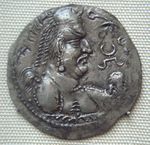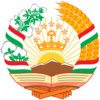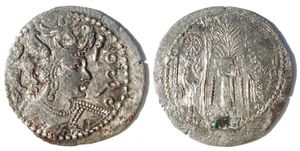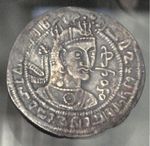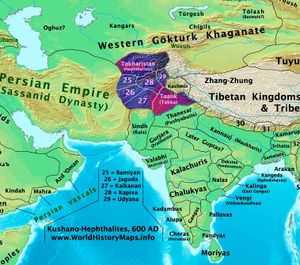الإمبراطورية الهفتالية
Hephthalite Empire | |||||||||||||||||||||
|---|---|---|---|---|---|---|---|---|---|---|---|---|---|---|---|---|---|---|---|---|---|
| 408–670 | |||||||||||||||||||||
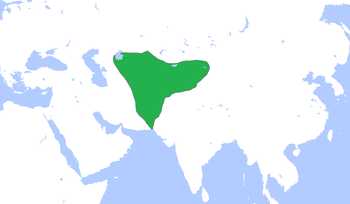 الهفتاليون (أخضر)، ح. 500. | |||||||||||||||||||||
| المكانة | امبراطورية بدوية | ||||||||||||||||||||
| العاصمة | كندوز (ولواليج، Drapsaka أو باديان) بلخ (پاخلو) سيالكوت (Sakala) | ||||||||||||||||||||
| اللغات الشائعة | الباكترية گندهاري (گندهارا) الصغدية (صغديانا) الخوارزمية الطخارية[بحاجة لمصدر] التوركية لهجات ساكا السنسكريتية | ||||||||||||||||||||
| الدين | Buddhism[1] Manichaeism[2] Nestorianism[بحاجة لمصدر] Tengrism[بحاجة لمصدر] Zoroastrianism[3] | ||||||||||||||||||||
| تگين | |||||||||||||||||||||
• 430/440 – ≈490 | خينگيلا | ||||||||||||||||||||
• 490/500 – 515 | Toramana | ||||||||||||||||||||
• 515–528 | Mihirakula | ||||||||||||||||||||
| الحقبة التاريخية | القدم المتأخر | ||||||||||||||||||||
• تأسست | 408 | ||||||||||||||||||||
• انحلت | 670 | ||||||||||||||||||||
| |||||||||||||||||||||
| Today part of | |||||||||||||||||||||
الهفتاليون Hephthalites؛ إفتاليت، أو يى-تاي كانوا اتحاداً لشعب بدوي ومستقر[4] في آسيا الوسطى وسّع نطاق سيطرته غرباً في القرن الخامس.[5] ومن غير الواضح إذا ما كان الهفتاليون أو شعب قريب، خيوني Xionites، قد ترادف اسمهم مع الهون البيض (السنسكريتية: سڤِتا هونا).
في أوج عظمتها في النصف الأول من القرن السادس، سيطرت الامبراطورية الهفتالية على أراضي في أفغانستان وتركمنستان وأوزبكستان وطاجيكستان وقيرغيزستان وقزخستان وپاكستان والهند والصين الحاليين.[6][7]
معقل الهفتاليين كان طخارستان في ما هو اليوم شمال شرق أفغانستان. بحلول سنة 479، كان الهفتاليون قد فتحوا صغديا وطردوا الكيداريين غرباً، وبحلول عام 493 كانوا قد استولواً على أجزاء من دزونگاريا الحالية و حوض تريم في ما هو اليوم شمال غرب الصين.
وقد غـُزِيَت الهند أثناء القرن الخامس من قِبل شعب يُعرف في جنوب آسيا بإسم هونا – الذي ربما كان تحالفاً أوسع من الهفتاليين و/أو الخيون. وكان الهونا في بادئ الأمر قد انهزموا أمام الامبراطور سكندرگوپتا من امبراطور گوپتا.[8] إلا أنه بنهاية القرن الخامس، فقد اجتاح الهونا الجزء من امبراطورية گوپتا الذي كان إلى الجنوب الشرقي منهم وفتحوا وسط وشمال الهند.[2] الامبراطور بانوگوپتا من آل گوپتا هزم الهونا الذين كانوا تحت قيادة تورامانا في 510.[9][10] طـُرِد الهونا من الهند على أيدي الملكين ياسودارمن و نراسماگوپتا، في مطلع القرن السادس.[11][12]
. . . . . . . . . . . . . . . . . . . . . . . . . . . . . . . . . . . . . . . . . . . . . . . . . . . . . . . . . . . . . . . . . . . . . . . . . . . . . . . . . . . . . . . . . . . . . . . . . . . . . . . . . . . . . . . . . . . . . . . . . . . . . . . . . . . . . . . . . . . . . . . . . . . . . . . . . . . . . . . . . . . . . . . .
أسماء العرق
الاسم "هفتاليون" ينحدر من مصادر يونانية قديمة، كانت تشير إليهم كذلك بالأسماء إفتالي Ephthalite ، و أبدل Abdel أو أڤدل Avdel.
In Ancient India, names such as Hephthalite were unknown. The Hephthalites were apparently part of, or offshoots of, people known in India as Hunas or Turushkas,[13] although these names may have referred to broader groups or neighbouring peoples. To the Armenians the Hephthalites were Haital, to the Persians and Arabs they were Haytal or Hayatila, while their Bactrian name was ηβοδαλο Ebodalo.[2]
In Chinese chronicles, the Hephthalites are called Yanda or Yediyiliduo or "Bikova", while older Chinese sources (c. 125) call them Hua or Hudun and describe them as a tribe living beyond the Great Wall in Dzungaria.[14] Although the Hephthalite Empire was known in China as Yàdā (嚈噠), Chinese chroniclers recognized this designated the leaders of the empire. The same sources document that the main tribe called themselves huá (滑).[15] The modern Chinese variation Yanda has been given various Latinised renderings such as "Yeda", although the corresponding Cantonese and Korean pronunciations Yipdaat and Yeoptal (بالكورية: 엽달) are more compatible with the Greek Hephthalite. Historians such as Christopher I. Beckwith, referring to Étienne de la Vaissière, say that the Hephthalites were not necessarily one and the same as the White Huns (Sveta Huna).[16] According to de la Vaissiere, the Hephthalites are not directly identified in classical sources alongside that of the White Huns.[17]
الأصول
التاريخ
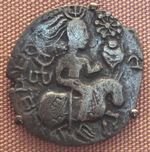 Hephthalite silver coin copying امبراطورية گوپتا horse type, القرن الخامس. |
المؤرخ البيزنطي من القرن السادس پروكوپيوس من قيصارية (الكتاب الأول، الفصل 3)، يربطهم بالهون في أوروبا:
The Ephthalitae Huns, who are called White Huns [...] The Ephthalitae are of the stock of the Huns in fact as well as in name, however they do not mingle with any of the Huns known to us, for they occupy a land neither adjoining nor even very near to them; but their territory lies immediately to the north of Persia [...] They are not nomads like the other Hunnic peoples, but for a long period have been established in a goodly land... They are the only ones among the Huns who have white bodies and countenances which are not ugly. It is also true that their manner of living is unlike that of their kinsmen, nor do they live a savage life as they do; but they are ruled by one king, and since they possess a lawful constitution, they observe right and justice in their dealings both with one another and with their neighbours, in no degree less than the Romans and the Persians[18]
الدين
الهون البيض في جنوب آسيا الوسطى
النسل
في الثقافة الشعبية
رواية اومبرتو إكو باودولينو تشير إلى "الهون البيض"، الذين تصورهم على أنهم عرق مقاتل مرهوب الجانب.
Eric Flint's Belisarius series makes frequent reference to Ye Tai warriors.
The White Huns is a playable faction in Total War: Attila. Somewhat anachronistically, they are portrayed as being led by Khingila in 396 CE. The game alludes to their conquest in India.
انظر أيضاً
- هونا (شعب)
- Kidarites (Red Huns)
- Kushan Empire
- Xionites
. . . . . . . . . . . . . . . . . . . . . . . . . . . . . . . . . . . . . . . . . . . . . . . . . . . . . . . . . . . . . . . . . . . . . . . . . . . . . . . . . . . . . . . . . . . . . . . . . . . . . . . . . . . . . . . . . . . . . . . . . . . . . . . . . . . . . . . . . . . . . . . . . . . . . . . . . . . . . . . . . . . . . . . .
الهامش
- ^ خطأ استشهاد: وسم
<ref>غير صحيح؛ لا نص تم توفيره للمراجع المسماةHabibi - ^ أ ب ت ث خطأ استشهاد: وسم
<ref>غير صحيح؛ لا نص تم توفيره للمراجع المسماةKurbanov - ^ خطأ استشهاد: وسم
<ref>غير صحيح؛ لا نص تم توفيره للمراجع المسماةAl-Hind - ^ Prokopios, Historien I 3,2-7.
- ^ Grousset, Rene (1970). The Empire of the Steppes. Rutgers University Press. pp. 67–72. ISBN 0-8135-1304-9.
- ^ Unesco Staff 1996, pp. 135–163
- ^ West 2009, pp. 274–277
- ^ Ancient India: History and Culture by Balkrishna Govind Gokhale, p.69
- ^ Ancient Indian History and Civilization by Sailendra Nath Sen, p.220
- ^ Encyclopaedia of Indian Events and Dates by S. B. Bhattacherje, p.A15
- ^ India: A History by John Keay, p.158
- ^ History of India, in Nine Volumes: Vol. II by Vincent A. Smith, p.290
- ^ History of Buddhism in Afghanistan, Alexander Berzin, Study Buddhism
- ^ Columbia Encyclopedia
- ^ Enoki, K. "The Liang shih-kung-t'u on the origin and migration of the Hua or Ephthalites," Journal of the Oriental Society of Australia 7:1–2 (December 1970):37–45
- ^ Empires of the Silk Road. 2009. p. 406.
- ^ de la Vaissiere, Etienne. "Huns et Xiongnu". Central Asiatic Journal (49): 3–26.
- ^ Procopius, History of the Wars. Book I, Ch. III, "The Persian War"
المصادر
- Grignaschi, M. (1980). "La Chute De L'Empire Hephthalite Dans Les Sources Byzantines et Perses et Le Probleme Des Avar". Acta Antiqua Academiae Scientiarum Hungaricae, Tomus XXVIII. Budapest: Akademiai Kiado.
- Haussig, Hans Wilhelm (1983). Die Geschichte Zentralasiens und der Seidenstraße in vorislamischer Zeit. Darmstadt: Wissenschaftliche Buchgesellschaft. ISBN 3-534-07869-1.
- Theophylaktos Simokates. P. Schreiner (ed.). Geschichte.
- Unesco Staff (January 1, 1996). History of Civilizations of Central Asia: The crossroads of civilizations, A.D. 250 to 750. UNESCO. ISBN 9231028464. Retrieved February 13, 2015.
{{cite book}}: Invalid|ref=harv(help) - West, Barbara A. (January 1, 2009). Encyclopedia of the Peoples of Asia and Oceania. Infobase Publishing. ISBN 1438119135. Retrieved January 18, 2015.
{{cite book}}: Invalid|ref=harv(help)
وصلات خارجية
- "The Ethnonym Apar in the Turkish Inscriptions of the VIII. Century and Armenian Manuscripts" Dr. Mehmet Tezcan.
- The Anthropology of Yanda (Chinese) pdf
- The Silkroad Foundation
- Columbia Encyclopedia: Hephthalites
- Hephthalite coins
- Hephthalite History and Coins of the Kashmir Smast Kingdom- Waleed Ziad at the Internet Archive
- The Hephthalites of Central Asia – by Richard Heli (long article with a timeline)
- The Hephthalites at the Internet Archive Article archived from the University of Washington's Silk Road exhibition – has a slightly adapted form of the Richard Heli timeline.
- (pdf) The Ethnonym Apar in the Turkish Inscriptions of the VIII. Century and Armenian Manuscripts – Mehmet Tezcan
- iranicaonline hephthalites
- مقالات ذات عبارات بحاجة لمصادر
- Articles with unsourced statements from February 2016
- Pages using infobox country with unknown parameters
- Articles containing كورية-language text
- هفتاليون
- جماعات بدوية في أوراسيا
- بلدان سابقة في آسيا الوسطى
- بلدان سابقة في جنوب آسيا
- هون
- شعوب إيرانية قديمة
- تاريخ تركمنستان
- تاريخ طاجيكستان
- تاريخ اوزبكستان
- تاريخ قيرغيزستان
- تاريخ پاكستان
- تاريخ أفغانستان
- تاريخ الهند
- تاريخ الصين
- خراسان القروسطية
- دول وأقاليم تأسست في 420
- انحلالات 670

